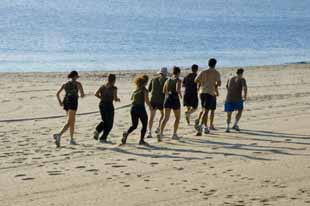How often should we exercise?
We should have at least 30 minutes of moderate-intensity exercise every second day at least. Even better health outcomes are seen with longer and more frequent workouts. But like any slow solution, it is best to take the time to progressively increase the level of activity and with it fitness and health. When starting a programme after a period of inactivity, exercising 3-4 times/week on alternate days is recommended, allowing a day of recovery between each session to assist recovery and adaptation to occur. The recovery days should be used to engage in lower intensity or a different type of exercise, such as resistance training, so the exercise stress is rotated.
How hard should we go?
To maximize the fitness and health benefits as we get fitter, we need to increase the exercise intensity from moderate to higher intensity. Rather than working at an intensity that would be perceived as ‘easy’, we need to exercise level which we would rate as ‘somewhat hard’ to ‘hard’. However we should exercise at a level which still enables us to conduct a conversation, which is often referred to as ‘talking pace’. If we can not talk while we are exercising we are working too hard.
Getting into your training zone
When undertaking aerobic exercise, such as walking or cycling, another simple way to determine if we are working at an appropriate exercise intensity is to monitor our heart rate during exercise. This can either be done by periodically take the pulse over a 30 second period during aerobic training, or by using a heart rate monitor. Research has shown that to achieve an optimum aerobic training effect, you need to work at above a minimum threshold heart rate. This threshold heart rate is based on a percentage of our maximal heart rate.
As a guide to establishing our aerobic threshold and our training ‘zone’, we must first estimate our maximal heart rate. This is calculated as:
Maximum Heart Rate = 220 minus our age (in years)
e.g. for a healthy 50 year old the maximal heart rate is 220 – 50 = 170 beats every minute
Sedentary individuals just starting an exercise program should initially aim to do sufficient work to get their hearts beating between 65-75% of their maximal rate (e.g. 110-128 beats per minute in a healthy 50 year old). Individuals who are already active should aim to work at 75-85% of their maximal capacity (e.g. 129-145 beats per minute in a healthy 50 year old). This will ensure we are obtaining the maximum benefit from our training, without over-stressing our heart and circulatory system. By self programming our heart rate monitor, the monitor will determine the optimal heart rate zone for us based on our age and heart rate. Many treadmills and bikes will have heart rate measuring hand pads on them as well.
It must be emphasized that this calculation applies only to healthy individuals. Those with chronic diseases or on medication will need individualized advice as to their appropriate and safe training zones. These individuals must seek advice from a doctor, an accredited exercise physiologist and/or a suitably qualified allied health professional.
Increasing exercise intensity above this aerobic training zone results in only small additional health benefits in most cases, and due to the safety concerns in older individuals, would generally not be recommended. Only healthy athletes would be recommended to exceed these levels for specific performance benefits. Short, repeated bursts of more vigorous exercise (such as performed in interval training) may have some additional health benefits. However, high intensity resistance or strength training has been shown to provide specific benefits when training individuals to increase their bone or muscle mass, and those with a chronic depressive illness.
Go to YouTube/slowaging to see Ian talk further on exercise and slowing aging. Ian Gillam, PhD, FAAESS, exercise physiologist and nutritionist, is an accredited exercise physiologist and nutritionist at the Wellness Clinic, National Institute of Integrative Medicine. Ian’s special expertise is in the prescription of exercise and nutritional programmes to slow the progression of the chronic diseases associated with aging.
Last Reviewed 02/Mar/2014

Latest posts by Ian Gillam (see all)
- How to start your strength training program - 14/01/12
- How hard should we exercise to slow aging? - 10/12/11
- Aging and exercise – ACSM guidelines - 07/07/11






